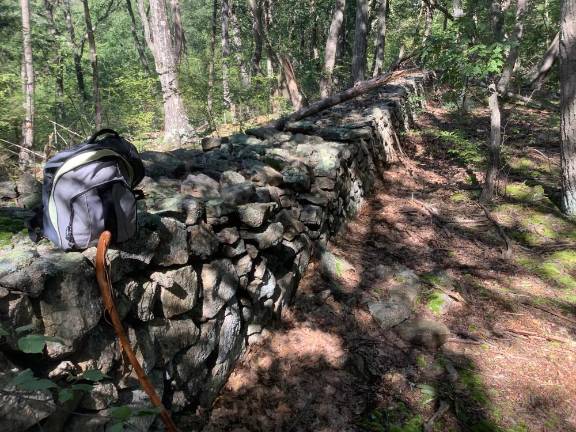
It is my pleasure to introduce again Vernon’s resident historian: Ron Dupont.
Ron is an avid researcher and recorder of what goes on in Vernon Township and has published two books on the area. He is also owner of the Highland Lakes Store.
Here is a great article on an often overlooked part of our county: stone fences.
Bill
***
The Mysterious Great Wall of Pochuck
By Ron Dupont
Spend any time hiking in the woods around here and you will notice stone walls - lots of them.
Properly called fences, they were built by the old farmers who needed to clear the land of stones for field and pasture and also build fences to divide land for different crops and livestock. Most were built from the late 1700s up to the Civil War.
Many are quite impressive, and some are well-preserved. Built with only manual labor and draft animals, they represent colossal effort and true historic craftsmanship.
Perhaps the most astonishing one I’ve ever seen is on Pochuck Mountain, north of Glenwood Mountain Road. If you walk the old trail north to Bank’s Ponds and take a left where it crosses the Appalachian Trail, you will come to it shortly.
It is four feet wide and four feet high with straight sides and a level top and runs arrow-straight for some 1,600 feet - about a third of a mile up hill and down dale.
Most old farm walls curve with the land to a degree and are more like linear rock dumps. Not this one: it was clearly built by professionals. It even includes a stream culvert.
By any conservative estimate, its construction involved hauling and laying up some 3.4 million pounds of fieldstone.
And as Vernon farmer Jamie Rickey pointed out to me, the fact that it is so well-preserved means it was built “by the book,” likely with a footing - meaning they dug a trench down four feet or to bedrock and filled it with rock for the whole thing. So add another few million pounds of earth removal and stone piling for that.
For years, my friends and I have called it “the Great Wall of Pochuck.”
Yet, at one end, the wall makes a 90-degree turn, heads down a ravine and simply ends at a creek. And at the other end, this massive construction simply stops, with a rough end - abandoned. A few hundred yards west is a nearly parallel wall of similar construction. But neither connects to the other. They enclosed nothing.
To employ the modern vernacular, “WTH?”
The short answer as to why it was built: I don’t know. But I have a theory, centered on one word: Sheep.
A good fence is essential for sheep - both to keep them in and predators out. As their stereotype suggests, sheep are generally easy to manage. But they can also be escape artists.
A cow or horse will regard a solid post-and-rail fence with begrudging respect. A sheep considers it an amusing challenge.
If sheep can see through a fence or over a fence or around a fence, they will decide that yonder lies true happiness and will try to bust out. Climbing, chewing, squeezing - whatever it takes.
Later, in the days of barbed-wire (c. 1870) and electric (c. 1930s) fencing, keeping sheep in was easier. But in the days of stone and split-rail fences, it was a challenge.
Basically, the farmer didn’t need a sheep field. He needed a sheep Stalag 17. Ideally, a wall so big and wide the sheep concluded that the universe ended there, quit playing Hogan’s Heroes and resigned themselves to grazing where they were.
The Great Wall of Pochuck would have been that kind of wall.
And it turns out the “Great Walls” and its western sibling do mark boundaries of a 56-acre parcel purchased from the East Jersey Proprietors by Joseph Sharp Jr. and Richard Edsall in 1804.
Sharp lived in Hamburg (then called Sharpsboro) and had interests in ironworks and milling; Edsall was a businessman and surveyor. They were involved in numerous commercial enterprises.
Such rough mountain terrain was really only good for grazing. Sheep were well-suited to such pasturage. And soon, sheep became the craze. Spanish Merino sheep produced the finest, softest wool, but their export was prohibited by Spain. This changed in 1807 (Napoleon had invaded Spain - it’s a long story). American farmers couldn’t snap up imported Marinos fast enough.
Soon, Merino sheep were fetching crazy money - up to $1,500 each. The War of 1812 drove prices even higher, and Merino sheep became a true speculative bubble - think Beanie Babies but with livestock.
With a flock of sheep worth a literal fortune, it would well be worth two investors like Sharp and Edsall hiring a contractor to build them a first-class wall to keep their expensive sheep in and predators out.
Unfortunately, the Merino boom soon became the Merino bust. Like all such bubbles, it crashed. A Merino previously worth hundreds of dollars now sometimes ended up on the dinner table. There were several such cycles with Merino sheep between 1815 and 1825.
And if such a Merino crash happened midway in their plans to build a magnificent stone sheep enclosure, any sensible entrepreneur would do the same thing: pull the plug. Hence it would remain unfinished.
Is that why this remarkable stone wall was built and left unfinished? We can’t know. But in New England, it’s generally reckoned that the majority of the stone walls in the woods were the result of the Merino sheep craze of the early 1800s, so the same could well be true here.
There is one thing I can say with certainty: I’m glad I didn’t have to build it.